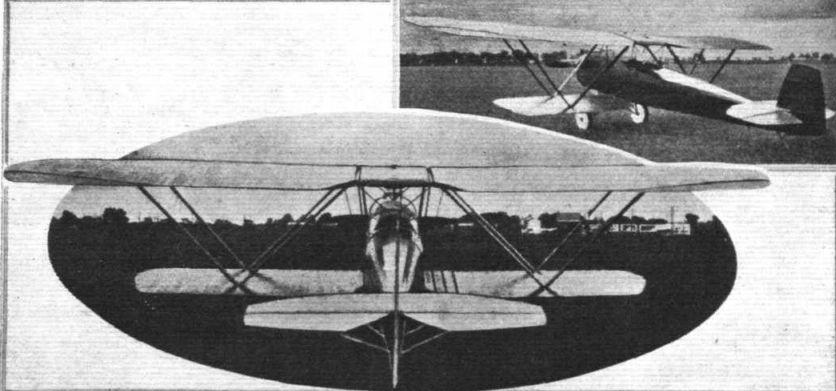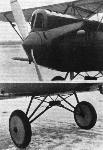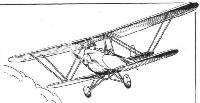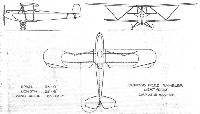Flight, November 1928
THE ALL-METAL LIGHT 'PLANE
Canadian Reid "Rambler"
THE flying club movement in Canada has spread rapidly during the last year and thereby made some of the most lucrative orders for manufacturers of light aeroplanes. Needless to say, England has had the greatest benefit of this progress and has certainly laid a firm foundation for continued success. Inevitably, though, designers are being attracted to such a promising market, and we see local production in the light 'plane class heralded by the appearance of the Canadian Reid "Rambler," of which brief reference was made in our columns recently.
Even in this local effort, however, an Englishman is the responsible person. The designer, Mr. W. T. Reid, was formerly of the Royal Aircraft Establishment and the Bristol Aeroplane Co., Ltd. He went to Canada some time ago as designer for Canadian Vickers, Ltd. Now he has formed the Reid Aircraft Company of Montreal, to produce his own design. The primary rate of production will be two a week, and when their plant is extended the rate will increase to seven a week.
One of the machine's foremost features is the all-metal construction. The experience of the manufacturers has apparently proved to them that a wooden machine would not be equal to the climatic conditions. The changes in temperature result in the expansion and contraction of wood. This Reid "Rambler" is a sesquiplane type, the top wing being of considerably greater area than the lower wing, and the usual folding qualities are applied. A very wide view from the two in-line cockpits appears obtainable owing to the small area of the lower wing.
Wing spars and ribs are made of a strong aluminium alloy. The ribs, which are one-piece pressings, are riveted to the spars. All internal bracing is tubular, whilst the vee-shaped interplane bracings are of streamline seamless steel tubing - which obviates rigging adjustments.
In the top centre plane is the gravity tank, with a capacity of 20 gallons. Seamless steel tubing is also employed in the design of the tail plane, elevators and rudder. The supporting struts for the tail plane from the fuselage are streamline steel.
A special type undercarriage, with a wheel track of 6 ft., involves a form of rubber buffer, consisting of a series of rubber discs of approximately streamline shape which become compressed under the shock of landing. Differential hydraulic brakes are standard. Tail skid is of simple design and the shoe is easily removable in the event of wear. A metal propeller is standard.
Skiis or twin floats are interchangeable with the land chassis. There is a dual control system, and an adjustable spring is fitted to the elevator controls to trim the machine in flight In the gravity feed system is fitted a tank cock so that in flight a quantity of petrol sufficient for half an hour's flight is trapped as an emergency supply.
Complete set of instruments is fitted on an indirectly lighted panel of automobile pattern, and there is a luggage compartment behind the rear cockpit. Engine installed is an A.D.C, "Cirrus" Mk. II.
Dimensions :- Length of machine when the wings are open is 22 ft. 6 in. and when wings are folded, 24 ft. 6 in. Span of wings, 33 ft. Width of machine with folded wings 11 ft. 1 in. Height, 8 ft.
Weights :- Machine empty weighs 850 lbs.; petrol (20 galls.) 145 lbs.; pilot and passenger, 180 lbs. each; luggage, 80 lbs. Useful load, 600 lbs. Total loaded weight is 1,450 lbs.
Performance :- Top speed, 102 m.p.h.; landing speed, 38 m.p.h.
Apart from utility for private owners, flying clubs and schools, the Reid "Rambler" has claims for forestry patrol work and transportation work where economical conveyance of single passengers or equivalent weight of freight is required. A certificate of airworthiness, issued by the Director of Civil Aviation, Ottawa, is supplied with every machine.
The Reid Aircraft Company is controlled by Capt. W. S. Lighthall (Chairman), Mr. W. T. Reid (President), Major T. C. Lamb, M.C. (Director) Capt. E. F. Peacock (Vice-President) and Capt. C. Barclay Drummond (Director). Mrs. W. T. Reid made the first passenger flight in the "Rambler" last September.
Показать полностьюShow all
Flight, June 1929
THE CURTISS-REID "RAMBLER”
A Canadian All-Metal Light Aeroplane
WHEN a designer can sit down with a clean sheet of paper, a clear perception of what he wants to do, with no necessity to study existing machinery or conform to previous shop-practice, it is only to be expected that an interesting machine will develop.
With a brand new factory at his disposal, not very extensive at present, but planned from the ground up for growth without complications, Mr. W. T. Reid, F.R.Ae.S., A.M.I.Mech.E., who has served with the Royal Aircraft Factory, Farnborough, with the Bristol Aeroplane Company, and more recently with Canadian Vickers, Ltd., has had full scope to produce a light, all-metal folding-wing machine with many outstanding features.
The "Rambler," as it has been named - and to which reference has already been made in FLIGHT - is entirely of Canadian design and manufacture, save for the Cirrus Mark III engine, which is its standard power plant. The only wood in the whole machine is the plywood flooring of the cockpits. Fabric covering of the metal fuselage and wing structure permits any distortion to make itself immediately apparent, and the interchangeability of many of the parts fits this machine particularly for use in the Dominions where distances are great and spare parts not always easily obtainable.
The wings are of sesquiplane design, the top plane having a span of 33 ft. and a chord of 5 ft. 6 in., while the lower plane measures only 22 ft. 5 in. in span and 3 ft. 9 in. in chord. The total wing area is 238 sq. ft., giving a loading at the normal lying weight of 6 lbs. per sq. ft. Both planes have an angle of incidence of 3° and a dihedral of 1°. The tubular spars are aluminium alloy, on to which are slipped the channel section, pressed metal ribs, of R.A.F. 15 camber, bored for lightness. Drift bracing is by diagonal tubes, rigidly attached to the spars and requiring no "rigging."
Interplane struts are of streamline seamless steel tubing, bolted to the spars, and forming a triangulated structure that requires no wiring, and consequently no adjusting. The rear spars are hinged to a bracket on the fuselage, and the front spars, when the wings are spread, are secured with steel pins that can only lock when fully inserted, and further tethered by a leather strap with a snap fastener. When folded, the machine has a spread of 11 ft. 1 in., and a height of 8 ft. The wings can be locked in the folded position. On account of the shortness of the lower plane, access to the empennage is not obstructed when the wings are folded.
The fuselage is of seamless steel tubing, longerons, struts and diagonal bracing being welded into one single unit. This unit is not treated internally with oil before it is sealed up. The designer contends that in a sealed structure such as this, there can be only a very small amount of moisture. The effect of that moisture, spread over the entire interior, must be negligible, but should one spot for some reason fail to receive its coat of oil, all the action of the moisture would be concentrated at that place, with possibly serious results.
Seamless steel tubing forms the tail plane, with an area of 15-2 sq. ft., elevators, and rudder. The tail plane is set at approximately 2° less incidence than the main planes, and the machine may be trimmed by means of a spring-loaded device, operated from the pilot's cockpit and attached to the elevator cables.
Conventional stick and rudder-bar controls are fitted in both cockpits, with the forward stick readily removable from its socket. Control wires are notably carried inside the fuselage and wing structure. Neither elevators nor ailerons have external king-posts. In the former case, the interchangeable flaps are bolted together centrally, and moved by a king-post extending downwards into the interior of the fuselage, where a push-and-pull rod transmits the motion of the cables. This is ordinary clean design, but in the aileron controls a new and interesting device is called into play. Note that the aileron is not hinged to the rear spar itself, but is inset in the trailing edge at an angle. This, incidentally, gives it a good grip of the "spill" of air from the wing-tip, especially near stalling speed. At an angle, again, to the aileron spar is hinged a tubular triangle, the apex of which forms a ball. On the rear main spar is bolted a chain sprocket, carrying a short arm, the extremity of which is bored to receive the aforementioned ball. The whole apparatus, which sounds complicated, but is really very simple, is contained inside the wing structure. The control cables, both of which run through the wing structure just back of the rear spar, operate the sprocket through an inset length of bicycle chain, and exert a very powerful leverage on the aileron with a light touch on the stick. The ailerons are interchangeable, and have a combined area of 8-94 sq. ft.
Two short king-posts, forming an inverted T, are the terminals of the rudder control wires. The steel post on which the balanced rudder, measuring 8-12 sq. ft., swings, is set at the extreme rear of the fuselage. No fin is fitted.
The "Cirrus" engine is conventionally mounted on four jugs welded in the fuselage construction, and is streamlined by neat hinged cowling. A point of interest is the grouping together in this cowling of a magneto switch, a throttle control and a dope-pump, for the convenience of solo pilots, obviating continual climbing in and out of the cockpit.
The original undercarriage of the "Rambler" is another feature of interest. Each side of the landing gear is a separate, identical and interchangeable unit, formed of three streamline steel tubes and three smaller tubes welded rigidly together. Two of the main tubes form a conventional-looking V, and are hinged to the fuselage at their upper ends. The third forms one half of the split axle, and is forked at its inner end, while carrying the wheel on a projection at the opposite end. The forks are secured to a shock-absorbing device that "floats" under the centre of the fuselage, to which it has no direct connection. An extreme flexibility is obtained by these means, and as the shock-absorbing unit adjusts itself to the load or impact on either wheel, there is a damping action between the two, calculated to avoid bouncing.
Hydraulically-operated brakes are to be fitted as a standard equipment, and here again forethought has been exercised towards nullifying their dangerous use. Both brakes are normally applied by means of a lever in the pilot's cockpit, but by connecting the tailskid to the circuit, no braking effect can be secured until weight rests on the skid, by which time there is no tendency to nose over. In taxying, either brake is brought into play separately when full rudder is applied, by means of a knob on the rudder cable that engages with a fork, still subject to the proviso of there being weight on the tailskid.
Deep cushions, which can readily be replaced by parachute packs are supplied in both cockpits, and the equipment includes a safety belt, Pyrene, tool-kit, a tail-handling device for moving the machine when its wings are folded, as well as the following instruments of consolidated make: airspeed indicator, rev. counter, altimeter, oil pressure gauge and compass. Baggage can be stowed in a large compartment aft of the pilot's seat, and both cockpits are provided with lockers for maps and other small articles.
Twin metal floats can be readily fitted instead of the wheel landing gear.
The empty machine weighs 850 lb. With 20 gallons of petrol in the top centre-section tank, 1 gallon of oil, pilot and passenger at 180 lb. each, and 80 lb. of baggage, the weight reaches 1,445 lb., at which the machine has full aerobatic factors as laid down by the I.C.A.N. It may be flown commercially under the same factors at an all-up weight of 1,650 lb., but may not be stunted. The service ceiling is set at 16.000 ft., with a rate of climb near the ground of 800 ft. per minute.
Показать полностьюShow all
Flight, May 1931
THE NEW CURTISS-REID "RAMBLER
A Possible Canadian Entry for King's Cup Race
THE Mk.III Inverted Gipsy engine has been responsible for a number of remarkable events, but none more pregnant than the entry of a Canadian designed and built machine in the classic King's Cup Race, which is followed as closely in the Dominion as in the Old Country itself. Readers of FLIGHT may remember that the Curtiss-Reid "Rambler" was described in these pages in the issue for June 27, 1929, and will perhaps recall that this machine is an all-metal, fabric-covered sesquiplane, with triangulated interplane strut system, and a clever inter-acting undercarriage.
The accompanying photographs of the latest product of this Montreal firm depict a machine that, while it still bears the name of its prototype, the "Rambler," outperforms the latter in every way, and is a good deal more attractive to the eye. The fitting of the inverted engine has pushed the top speed up to a conservatively claimed 126 m.p.h., and the cruising speed to upwards of 100, as well as raising the ceiling considerably. In this latter connection, it may be stated that, almost as soon as the machine was out of the shops, Capt. J. D. Parkinson, who will be remembered by thousands of English enthusiasts, took it up to an unofficial altitude record of 22,000 feet, although unseasonable cold caused his barograph to freeze at 18,000. The visibility from either cockpit has been so increased that there is no comparison. Smaller windshields are required on account of the much cleaner lines of the fuselage. The centre section is cut away forward further to increase visibility, and doors are fitted on either side of the front cockpit to facilitate entry and exit.
As the engine is mounted 9 in. forward of the old position, the undercarriage has been moved up slightly, and there is ample room now between the rear end of the power plant and the firewall that shuts off the front seat. With re-designed tail surfaces and mechanical tail-trimming, wheel-operated from either cockpit, the handling qualities of the machine are improved. A very attractive feature is the new engine cowling, each side being a single panel hinged at the top and capable of being lifted exactly like a motor-car bonnet, to a position in which it is held by a forked rod attached at its other end to the engine mounting, and folded away when not in use. With so many improvements, it seems almost a pity that this new model was not given a new designation - "Rapid" readily suggests itself.
Its pilot in the race will be Mr. John C. Webster, a popular director of the Montreal Light Aeroplane Club, who is a consistent entrant in sporting events sponsored by his club, in which he and his wife, also a member and a pilot, often pull off double events. The hopes and good wishes of fellow club members and of Montrealers at large - who are capable of an intense civic pride on occasion - will go with him in this venture. The entry is a last-minute business in more than one respect. Only a few hours remained between the time of making the decision to compete and the closing of entries. In the meantime the machine had to be flown to Ottawa to obtain its C. of A., without which the application for entry would not have been valid. A. H. S.
[We do not quite understand our contributor's remarks regarding the shortness of time for entering this machine, as the closing date for entries is 5 p.m., June 22, while late entries may be received up to noon, July 1. On making inquiries at the Royal Aero Club, we were told that so far they had not received an official entry for this machine. - ED.]
Показать полностьюShow all










